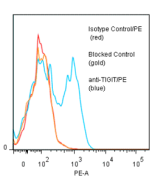Cookie Policy: This site uses cookies to improve your experience. You can find out more about our use of cookies in our Privacy Policy. By continuing to browse this site you agree to our use of cookies.
AdipoGen Life Sciences
VSTM5 (mouse):Fc (mouse) (rec.) (non-lytic)

| Product Details | |
|---|---|
| Synonyms | V-set and Transmembrane Domain-containing Protein 5 |
| Product Type | Protein |
| Properties | |
| Source/Host | CHO cells |
| Sequence |
The extracellular domain of mouse VSTM5 (aa 28-146) is fused to the N-terminus of the mouse Fc IgG2a (non-lytic mutant). |
| Crossreactivity | Mouse |
| MW | ~60kDa (SDS-PAGE) |
| Purity | ≥95% (SDS-PAGE) |
| Endotoxin Content | <0.01EU/μg purified protein (LAL test). |
| Concentration | 1mg/ml after reconstitution. |
| Reconstitution | Reconstitute with 50µl endotoxin-free water. |
| Accession Number | Q9D806 |
| Formulation | Lyophilized. Contains PBS. |
| Protein Negative Control | |
| Other Product Data |
Uniprot link Q9D806: VSTM5 (mouse) |
| Shipping and Handling | |
| Shipping | BLUE ICE |
| Short Term Storage | +4°C |
| Long Term Storage | -20°C |
| Handling Advice |
After reconstitution, prepare aliquots and store at -20°C. Avoid freeze/thaw cycles. Centrifuge lyophilized vial before opening and reconstitution. |
| Use/Stability |
Stable for at least 6 months after receipt when stored at -20°C. Working aliquots are stable for up to 3 months when stored at -20°C. |
| Documents | |
| MSDS |
 Download PDF Download PDF |
| Product Specification Sheet | |
| Datasheet |
 Download PDF Download PDF |
The V-set and transmembrane domain-containing protein (VSTM) family is composed of 8 proteins: VSTM1v1, VSTM1v2, VSTM2a, VSTM2b, VSTM2L, VSTM3, VSTM4 and VSTM 5. Members of the VSTM family are associated with the regulation of functions of immune cells, adipose cells and neuronal cells. The VSTM family is an immunoglobulin (Ig) superfamily that shares structural similarities with the B7-like transmembrane proteins involved in immune regulation. VSTM1 and VSTM4 play positive and negative roles in macrophage activation, respectively. VSTM3 (TIGIT) acts as a co-inhibitory receptor that suppresses the cytokine production of T cells and NK cells.
V-set and transmembrane domain-containing protein 5 (Vstm5), a newly characterized small membrane glycoprotein highly expressed in the CNS, facilitates the formation of neuronal dendrites and protrusions such as dendritic filopodia. Regulatory roles of VSTM5 for in vitro and in vivo immune responses have been reported. VSTM5 functions as a novel immune checkpoint by regulating T cell proliferation and cytokine production, Treg generation by maintenance of T cell energy and possibly induction of T cell apoptosis.
- VSTM5 is a novel immune checkpoint that promotes oral tolerance of cell-mediated and antibody responses: O.E. Oludada, et al.; BBRC 635, 283 (2022) [General Reference]







